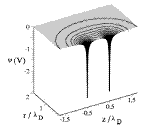Electrical and Computer Engineering, Department of
Document Type
Article
Date of this Version
April 1994
Abstract
An interferometric method that was used to measure the electro-optic s11 coefficient of nitrobenzene is presented. The method uses a Mach-Zehnder interferometer arrangement that produces a finite fringe interferogram. A nitrobenzene Kerr cell is placed in one arm of the interferometer and a pulsed high voltage is applied to the two rectangular electrodes. The voltage application causes the fringe image to shift in time, and this fringe shift is measured by a streak camera that streaks the fringe image across a slit. The streak start time is chosen before the application of the voltage pulse and ends after the voltage pulse has been applied. Thus continuous observation of the event is possible. By accurately measuring the fringe shifts the electro-optic s11 coefficient can be determined. The experimental arrangement is described, and the results obtained are discussed.



Comments
Published in APPLIED OPTICS/1 April 1994 / Vol. 33, No. 10. Copyright © 1994 Optical Society of America. Used by permission.